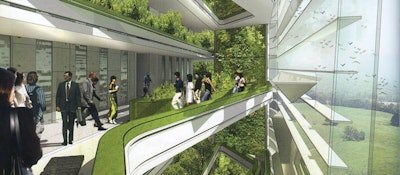
A July 2005 AB article titled "Imagine Today the Impact on Rec of Tomorrow's Tech" envisioned a "not-too-distant future" scenario of a man approaching his recreation center, the door opening automatically after a scanner detects the chip implanted in his body, and a robot with artificial intelligence regarding the member's attendance history greeting him by name and escorting him to the locker room. The fictional Mr. Allen's "smart" fitness clothes share workout feedback, music selections and email messages.
Nearly 15 years removed from that futuristic view, AB sought a prediction reset from a broader field of architect contemporaries. The results span the familiar and the seemingly fantastical. Imagine yoga pants that vibrate to prompt proper technique, or robots that can serve as personal trainer, game referee and after-hours custodian. The rec center of the future is one that may facilitate everything from virtual reality basketball to real live beekeeping, representing both a continued embrace of technology and, as one architect sees it, the inevitable tech backlash.
Here's a quick reading of the tea leaves.
Programming
According to architects entrusted with designing recreation centers that won't be obsolete in 20 years, today's emphasis on individual wellness will still be tomorrow's news.
"Data continues to indicate that the next generation of students will need more resources for their physical and mental health," says Colleen McKenna, a principal at CannonDesign. "Colleges and universities are uniquely positioned to advance a new wellbeing model, and recreation centers will be the epicenter of their efforts."
"We are seeing an increase in smart buildings and smart technologies throughout the design industry," says Sasaki associate Emily Parris. "The recreation center, as a key support for individual wellness, should continue to customize and adapt to the behaviors and use patterns of individuals by using the latest smart technologies. Data gathered from smart buildings can inform decisions around temperature control, lighting and acoustics to enhance comfort and capture energy savings. Additionally, collecting user input and traffic patterns through integrated systems can help to inform facility programming, ultimately increasing efficiency and accessibility for participants."
RDG Planning & Design's Nathan Harris predicts the recreation center of the future will not only be "a one-stop shop for all things wellness," it will become "the nucleus of major wellness developments within communities that will include hospitals, healthy restaurants, farmers markets, skate parks, amphitheaters, community gardens, water features, splash pads, ninja courses, etc." The rec centers themselves will address wellness through a combination of spaces and programming, Harris adds. "Spaces like teaching kitchens for nutritional education, classrooms for financial education classes or for religious groups to gather, and massage rooms for relaxation," he says. "Programs like trauma yoga to help victims of traumatic events connect with others and find comfort in knowing others are going through similar situations, nature therapy to connect participants with the outdoors, and sound therapy to relieve stress or anxiety."
Says Sasaki's Parris, "In response to an increasing need for mindfulness and stress management, I anticipate we will see a focus on environmental wellness. Programming for activities and spaces that allow people to interact with nature in sustainable ways — such as organic gardening, composting programs, and maybe even beekeeping — can relieve individual stress and contribute positively to our communities."
As McKenna sees it, "exercise as medicine" will be more than just a slogan, it will be the key to longevity for future generations, just as it has been for Baby Boomers. "This age group, and the generations to follow, are staying active and exercising later in life," she says. "This new reality will span a variety of new, hybrid activities focused on both mental and physical wellness. It will continue to put extraordinary pressure and demand on recreation facilities to accommodate multigenerational populations determined to keep moving."

Virtual reality
As a participant in the panel discussion "Fad or Future? Innovations in College and Community Recreation and Aquatic Center Design and Programming" at AB Show 2018 in New Orleans, Erik Kocher looked decades into the future of recreation. He suggested a future not unlike that depicted in Earnest Cline's 2011 best-selling novel Ready Player One (and in the Steven Spielberg-directed 2018 movie adaptation), in which activity in the year 2044 incorporates haptic technology — that is, simulated sense of touch.
"The buildings we are designing and constructing now will be only 28 years old in 2044 and should still be in great shape and flexible enough to be reconfigured to meet the future demands of recreation," says Kocher, a principal at Hastings+Chivetta. "Imagine a future in which recreation centers are warehouses of haptic rigs — spheres — with all participants playing basketball, racquetball and soccer, fencing and perhaps even swimming and diving together. You could potentially be playing with your friend right next to you or your avatar friend who is on the other side of the world. All you would need are your compact visor and lightweight haptic suit and gloves, and you are ready to go."
Virtual reality has the potential to get fantastical, according to Kocher. "Now, for those of you who have a traditionally designed and constructed recreation center, imagine you and your friends donning your visor, haptic suit and gloves for a game of five-on-five basketball in the existing gym," he says. "In this case you are actually running up and down the court, shooting baskets, guarding your opponents, shooting free throws, but this time your avatar is Magic Johnson and it is the 1984 NBA Finals.
"You can imagine almost every activity in your existing recreation center as an avatar experience. Even the simple act of running on a treadmill could instead be experienced as a run through the woods of Germany or along a beach in Hawaii. Of course, today's VR equipment remains heavy and clunky and cannot track real objects like a basketball. But who knows in the recreation center of the future?"
According to McKenna, the answer may come sooner than 2044. "We're going to see fitness classes taught in virtual reality and other online programming opportunities skyrocket in the next 10 years," she predicts. "Every activity will be highly customized. Instant feedback and data gathering will allow colleges and universities to modify recreational programming in an instant to address their populations' specific needs."
VR will even spare architects from having to modify the recreation center itself. Says Sasaki's Parris, "With just a set of goggles and an open room, VR experiences can be augmented and expanded with just a software upgrade, rather than a disruptive building renovation."
Stephen Springs, senior principal at Brinkley Sargent Wiginton Architects, likewise sees the future of recreation through VR headgear, but with even more dimensionality and sensory immersion. "One of the technological innovations that I think is definitely within reach for recreation facilities takes the concept of VR one step further with three- and four-dimensional environments. For example, the recent introduction of the data-driven design tool Hyperform allows architects and planners to collaborate globally in augmented reality. Imagine replacing the collaborating designer with a hiking partner in an exotic locale or Sugar Ray Leonard as a boxing partner," Springs says. "Beyond that, developers eventually could introduce additional sensory details into the VR environment, including smells and temperature changes."

Design flexibility
As software evolves and expands the realm of recreation possibilities, emerging materials technologies also give rec center designers broader building options than in the past.
RDG'sHarris points to ETFE (ethylene tetrafluoroethylene), the lightweight alternative to glass that has been popping up in professional sports venues, such as U.S. Bank Stadium in Minneapolis. "This plastic material transmits light like glass, but at just 1 percent of the weight," he says. "Use of this material will allow for maximum natural daylighting and provide column-free spaces that offer complete flexibility. Northern climate wellness centers will replicate outdoor environments with natural settings. They will become indoor parks for use year-round."
James Braam, senior principal and director of Sports + Recreation + Entertainment at HOK, predicts facilities will seek more open environments without sacrificing security. "The future wellness center will need and have unthinkable technology when it comes to safety and security," Braam says. "Fitness trackers will evolve into a dual purpose as an identity tracker. Facial recognition will be accessible and infinite, replacing the need for expensive security turnstiles. All the while, the spaces we design will bring people together like never before. It will be a welcoming, inclusive environment, and at the forefront of social interaction. Group exercise will be the highest demanded activity and yet likely will no longer be defined by a room with walls and a door.
"We are currently pioneering the potential for the ultimate indoor/outdoor space. The future will recognize this opportunity as a return to natural air, natural light and holistic health. And as the cost of indoor construction increases, the ability to capture the outdoors brings us full circle back to wellness."
Traditional sports activities, too, will benefit from technically advanced building concepts, according to Harris. "Implementing the use of glass gym floors with LED court striping provides quick changeover from basketball to volleyball or pickleball," he says. "Installing synthetic turf fields made of fiber optic light will provide quick turnover from a soccer field to a lacrosse field."
Inclusivity
Whatever nuance the future brings, the goal of recreation centers will forever be to engage as many individuals as possible in ways intense and subtle.
"We are looking at smaller-scale lifestyle integration," says Tracy Coker, associate principal at Dewberry. "The current thinking around lifestyle environments is mostly limited to shopping and restaurants; they are not being created around wellness. We are thinking about how to build a community around recreation and wellness. These need to be highly connected experiences that are curated for each individual. Your in-between time can be geared toward wellness at multiple times and places — however it can fit into your life. When it is easy to integrate wellness into the little bit of time you have in the day, your ability to make incremental changes to your lifestyle improves holistic wellness."
Braam sees the popularity of High-Intensity Interval Training being leveraged to incorporate a sort of high-intensity mindfulness, as the next generation pioneers a new spirit of wellness. "Our bodies are more powerful when they are led by the intentionality of the mind," he says. "And the beauty of it all is that it is done in a group setting. As a society, we are longing for connectivity. Modern research is pleading with us to disconnect from our phone and reconnect with others. Therapy counselors will be actually authoring prescriptions for exercise, and if it is a hybrid facility, they will walk users across the hall to begin."
As for Mr. Allen and his recreation center experience involving implanted chips, robotic escorts and communicative clothing? "Interestingly enough, almost all of these predictions now exist in some fashion," says Harris of RDG, the firm that authored the 2005 article in AB. "Not all have been adapted by campus or community recreation centers, but the fact that all these predictions have advanced from concepts to reality is exciting. It also means aim high with your ambitions of what could one day be the norm."
From campus to communityRecreation center designers continue to re-envision the state of the art in terms of form and function, with no end in sight. This is especially true within the collegiate recreation space, but the result is far-reaching. "The campus recreation center arms race of the late 1990s and early 2000s considerably raised the bar for what young college graduates expect from their community's public recreation center," says architect Stephen Springs of Brinkley Sargent Wiginton. "That has influenced the design of public facilities and the programming that takes place within them." Once considered bold programming at the community rec level, amenities such as climbing areas, cycling studios and boxing gyms are making way for a diverse new palette that can include black-box theaters, artist-in-residence galleries and studios, internet radio stations, recording and film-editing studios, culinary kitchens and giant all-inclusive playgrounds. An increasing number of recreation centers are sharing footprint space with other civic interests — from community service departments to libraries. "Officials at recreation departments and libraries often are inadvertent adversaries when it comes to non-physical-activity programming for children and teens — think afterschool opportunities, computer classes and maker spaces," says Springs. "Rather than creating a dividing line, why not combine both entities under one roof and save on building, maintenance and operations costs?" It's a different type of recruitment at the community level, but no less an arms race. "The arms race in campus rec is moving to the suburbs as a different animal," Springs says. "In growing local communities, that arms race is about attracting quality employers — and their employees with disposable income. Future quality-of-life amenities must have much broader appeal among wide demographics. They will have to offer much more than they do now, or at least more than their neighbors." |
This article originally appeared in the September 2019 issue of Athletic Business with the title "The rec center of the future: both familiar and fantastic." Athletic Business is a free magazine for professionals in the athletic, fitness and recreation industry. Click here to subscribe.





































